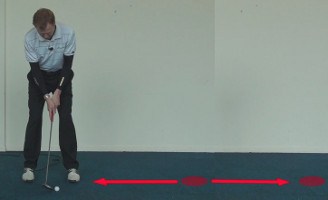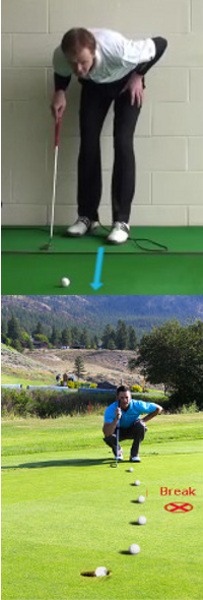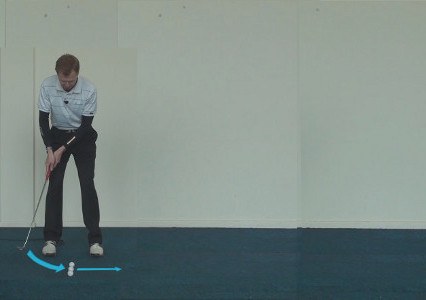If you struggle with “lag” putts – those from outside 30 feet where the goal is to get the ball within a few feet of the hole – a change in approach might just do the trick. Rather than thinking of the lag as one long putt, break it into two segments, from ball to hole.

Let's say you've got a 45-foot putt. Proceed as follows:
- Find the approximate midpoint of the putt.
- Read the green from this spot to the hole, as though you're putting from here.
- Now read the first half of the putt, from your ball to the midway spot. Keep in mind that the putt will break less than the slope indicates in this range because it will be traveling faster (you must hit it well past the halfway point, after all).
- Visualize putting to the midway spot, with enough speed to carry the ball from that spot to the hole on the intended line.
Always remember that on lag putts – except those which break severely – getting the right speed is more important that the right line.
Long putts are always a challenge

When you face a long putt – something in excess of forty or fifty feet – you immediately think about getting off the green in just two putts. You know that it is highly unlikely that you'll be able to make the first putt. You also know that taking three putts to get off any green is never a desirable outcome. If you can lag that first putt up within close range of the cup, you should be able to tap in and move on happily. But, of course, doing so is easier said than done.
To successfully deal with long putts, you need to make sure you have a plan. In this article, we are going to talk about one specific way you can approach your long putts to give yourself a fighting chance at a positive outcome. By breaking the putt down into segments, it will be less intimidating to read the putt and pick out a line and speed. This is a plan used by many golfers, including some of those at the highest levels of the game. Many players have had success with this approach, and we think it will benefit your game as well.
Of course, even if you do successfully read your long putt by breaking it down into segments, you still face the task of executing the putt. Without the ability to roll the ball in the right direction with the right speed, even the best read in the world isn't going to do you any good at all. So, in addition to the strategic discussion in this article, we will also offer some mechanical tips you can use when facing long putts. Only when the physical and mental sides of your putting game are both prepared will you be able to handle long putts properly time after time.
All of the content below is based on a right-handed golfer. If you happen to play left-handed, please take a moment to reverse the directions as necessary.
Why Segments?

It can be difficult to read a long putt, if only because there is so much information to take in. Unless you happen to be hitting a putt along a particularly flat section of green, you probably have to consider at least one break, if not two or three. There is also going to elevation change to deal with, and even that may be complicated, since the green could move up, then down, and back up again by the time you reach the hole. Trying to deal with this entire read all at once could overwhelm you to the point where you get frustrated and just throw up your hands. Instead of waving the white flag on these kinds of putts, breaking the read up into segments is a good way to get a handle on the challenge.
When you break up a long putt into segments, you will be simplifying the process of getting your read. Instead of trying to analyze the whole thing from start to finish, you will instead read smaller chunks, one at a time. Then, when you have each of your reads, you can bring them together to figure out the line and speed that you wish to use. This isn't necessarily going to make it easy to get a good read, and it certainly isn't going to make the putt itself easy, but it can make it more manageable.
If you would like to try the technique of breaking up your long putt reads into smaller segments, consider the tips listed below.
- Start with the end. It might be counterintuitive, but you should read the end of your putt first. The end of every read is going to be the most important segment of the putt, as this is when the ball will be rolling the slowest. The ball is going to take more of the break as it slows down, so you need to be sure that you get this part right. Walk to a position behind the hole and crouch down so you can get a good view of the green. Read the last ten feet or so of the putt, both for side to side break and for elevation change. Essentially, you are trying to figure out where your ball should be when it enters this phase of the putt. Is the end of the putt going to be pretty straight, or will it break hard from one side to the other? Get comfortable with the end of the putt and then move on from there.
- Go back to the beginning. With the end of the putt under control, walk back to your ball and read the first ten feet of the putt. This is also an important phase of the putt, as misreading the start of the putt could cause you to be way off track by the time the ball approaches the hole. Specifically, you'll want to pay attention to elevation change at the beginning. If the putt is uphill right from the start, making solid contact is going to be essential. On the other hand, if the putt heads downhill immediately, you can afford to ease your way into it in most cases. You are going to read the start of the putt in the same manner that you read the end – crouch behind the ball, get a good view, and evaluate the slope of the ground for roughly the first ten feet.
- Dealing with what remains. Now that you've evaluated the start and end of the putt, go ahead and figure out what to do with everything else. How does the green look in the middle section of the putt? The ball will likely be travelling at a decent rate of speed through this section, so it may not take as much of the side to side break as it will take near the end of that putt. Still, you can't ignore the slopes you find here. Once you have taken a moment to check out the middle of the putt, you will have all the information you need to bring everything together.
During your next practice putting session, try setting yourself up for a long putt across the green. Take a moment to read the putt just as you would do during a round on the course. Walk down to the hole so you can read the end of the putt, and then walk back up to the ball to read the beginning. Picture how the different segments of the putt are going to work together, and then pick a line and speed that you think will get the job done. Practicing this process on the putting green is the only way to make it work for you out on the course. It may take a bit of time to actually read your long putts in practice like this, but your effort will be rewarded in the long run. Remember, putting practice should be all about quality, rather than quantity. Don't worry about the sheer number of putts you hit while practicing, as long as the putts you do hit are helping you get better for the challenges you face in this part of the short game.
The Right Mental Approach

It's one thing to get a good read on your long putt. It's another thing entirely to actually have confidence when you step over the ball to make the stroke. You may have a hard time believing in the read you have made, especially since you are standing so far from the target. It may be hard – or even impossible – to see the hole from where your ball is located, so you need complete trust in your planning.
The list below is going to provide you with three mental keys for handling long putts successfully. If you have trouble on the mental side when putting from across the green, we think these tips will help.
- Picture a circle around the hole. This is a classic piece of golf advice, and you may have heard it before. When putting from long range, try to visualize a circle around the hole, and use that imaginary circle as your target. An imaginary circle doesn't have exact dimensions, of course, but try to picture something approximately six feet in diameter, with the hole right in the middle. That way, if you manage to roll the ball into your imaginary target, you will be left with a putt of no more than three feet. That should be considered a success from long distance, and you'll only need to make a solid stroke from short range to finish up your two putt.
- Think about the stroke, not the result. As you stand over the ball, try not to think about how important it is to roll the ball up close to the hole. You don't need to put any additional pressure on yourself. Instead, focus on executing a solid stroke back and through. By focusing on the process rather than the result, you should find that your mind is in a better, more relaxed state. This is a great tip to use in concert with the previous tip on picturing a bigger target around the hole. Imagine the larger target, use that to give yourself confidence, and then return your mind to thinking about the stroke. The goal here is to have your mind feeling relaxed and confidence when the putter starts in motion. That might not seem like a big deal, but it is going to help you achieve better outcomes on a regular basis.
- Forgive yourself. This last point has to do with the shot that lead up to your long putt. If you were in the fairway with a relatively short approach shot, you might be frustrated that you wound up so far away from the hole. You probably hoped to do better, and your frustration may still be simmering when you arrive at the green and get ready to putt. There is nothing wrong with expecting yourself to hit solid approach shots, but it isn't going to help to stay mad at yourself while you should be focused on hitting a great putt. Do your best to let go of your frustration and simply think about two-putting successfully. There are plenty of opportunities to get frustrated during the average round of golf. If you aren't able to maintain your cool, it will be impossible to live up to your potential.
The mental side of long putts is nearly as important as the physical side. Of course, that is something that can be said for the game of golf as a whole. This is a challenging game from a mental perspective, yet most amateurs worry only about improving their physical skills. If you would like to gain an edge on your competition at the local club, try working on your mental game during practice. By using your mind to your advantage, you may even be able to beat players with superior physical skills.






